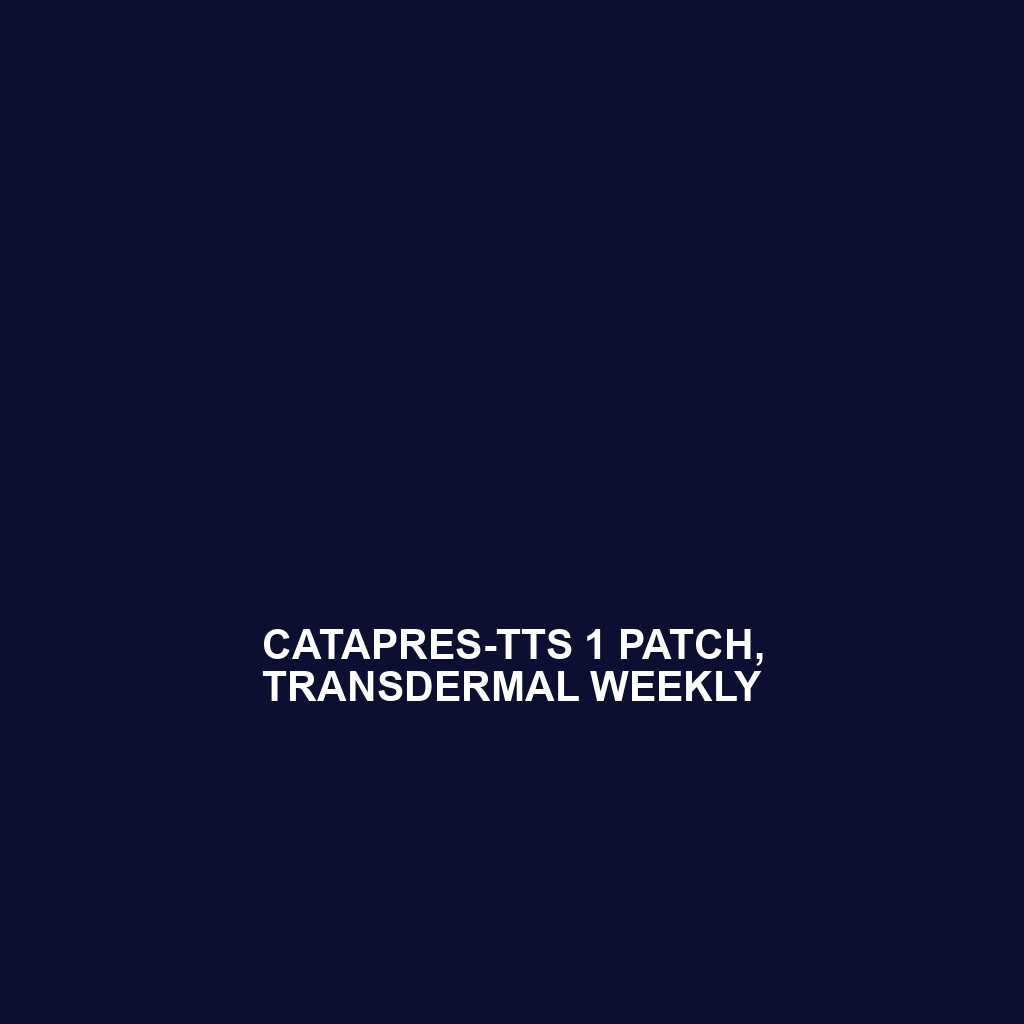Catapres-Tts 1 Patch, Transdermal Weekly:
Definition and Description of Catapres-Tts 1 Patch, Transdermal Weekly:
The Catapres-TTS 1 patch is a transdermal delivery system that releases clonidine, an alpha-2 adrenergic agonist, into the bloodstream over a one-week period. It is primarily used for the treatment of hypertension (high blood pressure) and may also assist in alleviating certain symptoms of opioid withdrawal. The patch provides a steady release of medication, ensuring consistent blood levels and minimizing peaks and troughs associated with oral dosing methods.
Causes of Catapres-Tts 1 Patch, Transdermal Weekly:
The underlying cause for the use of the Catapres-TTS 1 patch generally pertains to unmanaged hypertension or the need for opioid detoxification support. Factors that lead to hypertension include an unhealthy diet, obesity, sedentary lifestyle, excessive alcohol consumption, and genetic predispositions. Clonidine works by affecting certain receptors in the brain, resulting in a decrease in heart rate and blood pressure.
Associated Symptoms of Catapres-Tts 1 Patch, Transdermal Weekly:
Patients using the Catapres-TTS 1 patch may experience symptoms associated with hypertension, including headaches, dizziness, blurred vision, and fatigue. Other common side effects may include dry mouth, sedation, and constipation, particularly when beginning treatment or when dosages are adjusted.
Diagnosis of Catapres-Tts 1 Patch, Transdermal Weekly:
Healthcare professionals typically diagnose hypertension through routine blood pressure screenings. A diagnosis may also involve reviewing the patient’s medical history, conducting a physical examination, and possibly implementing supplementary tests to assess the patient’s overall health. In patients undergoing opioid withdrawal, diagnosis may include evaluations of withdrawal symptoms and dependence histories.
Risk Factors for Catapres-Tts 1 Patch, Transdermal Weekly:
Individuals at greater risk for utilizing Catapres-TTS 1 include those with a family history of hypertension, older adults, and individuals who lead unhealthy lifestyles. Additionally, those with existing mental health disorders, ADHD, or patients undergoing chronic pain management may also be prescribed the patch, as clonidine can assist in managing certain symptoms related to those conditions.
Complications of Catapres-Tts 1 Patch, Transdermal Weekly:
If left untreated, chronic hypertension can lead to significant complications, including heart disease, stroke, kidney damage, and vision loss. Furthermore, improper use of the Catapres-TTS 1 patch, such as sudden discontinuation, may induce withdrawal symptoms, including increased blood pressure, anxiety, and restlessness.
Treatment Options for Catapres-Tts 1 Patch, Transdermal Weekly:
Treatment often starts with the Catapres-TTS 1 patch, though healthcare providers may also recommend lifestyle modifications such as dietary changes, regular physical activity, and stress management. Other antihypertensive medications can be prescribed depending on the patient’s overall health and response to treatment. In cases of opioid withdrawal, the patch assists in managing withdrawal symptoms and cravings.
When to See a Doctor for Catapres-Tts 1 Patch, Transdermal Weekly:
Patients should seek medical attention if they experience significant side effects such as severely low blood pressure, extreme fatigue, or hallucinations. Additionally, if symptoms of withdrawal become difficult to manage or if there are concerns about side effects from the patch, a healthcare professional should be consulted promptly.
Prevention of Catapres-Tts 1 Patch, Transdermal Weekly:
Preventive measures include regular health check-ups to monitor blood pressure, maintaining a healthy lifestyle, reducing sodium intake, ensuring regular physical activity, and managing stress levels. For individuals recovering from opioid dependence, counseling and support groups are highly recommended to foster a supportive environment and mitigate relapse risks.
Statistics and Prevalence of Catapres-Tts 1 Patch, Transdermal Weekly:
Current data indicates that about 1 in 3 adults in the United States is affected by hypertension, making it a prevalent condition for which Catapres-TTS and other antihypertensive treatments are utilized. Despite its effectiveness, the use of the Catapres-TTS patch is less common compared to oral medications, primarily due to patient preferences and familiarity with oral dosing.
Personal Stories or Case Studies about Catapres-Tts 1 Patch, Transdermal Weekly:
Many patients have reported positive outcomes with the Catapres-TTS 1 patch, experiencing stable blood pressure levels without the frequent need for medication adjustments. Case studies indicate that patients who have used the patch during opioid withdrawal found it effective in managing their symptoms and facilitating a smoother recovery process.
Myths and Misconceptions about Catapres-Tts 1 Patch, Transdermal Weekly:
A common myth is that transdermal patches like Catapres-TTS are less effective than oral medications. In truth, for many patients, patches provide consistent therapeutic levels of medication and are easier to use. Additionally, some believe the patch can only be used for hypertension, while it’s also beneficial for managing withdrawal symptoms in patients recovering from opioid dependence.
Support and Resources for Catapres-Tts 1 Patch, Transdermal Weekly:
For those seeking more information and support regarding hypertension and the use of Catapres-TTS 1, numerous resources are available. Consulting healthcare professionals or visiting this support page can offer guidance and community support.
Conclusion about Catapres-Tts 1 Patch, Transdermal Weekly:
In summary, the Catapres-TTS 1 patch is a valuable tool in managing hypertension and assisting with opioid withdrawal. Understanding its usage, potential side effects, and associated benefits can empower patients to make informed decisions about their health. Seeking regular medical advice and support is crucial for successful treatment outcomes.
